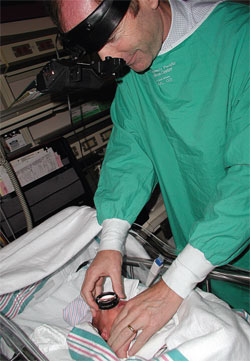 |
| Adults born preterm and treated for ROP had worse refractive error in this study cohort. Click image to enlarge. |
Retinopathy of prematurity (ROP) in babies born preterm is becoming an increasingly common occurrence, as approximately one in 10 newborns today are born before their due date. Research has shown that adults who were born preterm are at increased risk for developing myopia and anisometropia; however, it has failed to differentiate between patients with varying birth weight, gestational age (GA) and instance of postnatal ROP.
A closer investigation of the long-term effects in this population is needed, which is why a group of researchers recently conducted an analysis of participants from the Gutenberg Prematurity Eye Study (GPES) including adults aged 18 to 52 born either preterm or full-term. Two findings were determined from the data: ROP patients treated with cryocoagulation and laser coagulation had increased refractive error, increased lens opacifications and reduced accommodation. In addition, preterm delivery was found to be associated with anisometropia in adulthood, though its effect on absolute refractive error was small in the absence of postnatal ROP.
A total of 856 eyes (433 patients) included in the GPES study were accounted for in the analysis. The researchers assessed three primary outcome measures—refractive error, accommodation amplitude and lens opacification—and then divided the cohort into six groups: normal GA ≥37 weeks (control group), preterm participants without ROP and GA 33 to 36 weeks (group two), GA 29 to 32 weeks (group three), GA ≤28 weeks (group four) and those with ROP without (group five) or with treatment (group six).
The refractive errors measured in patients of each group are illustrated in Table 1. Though adults born preterm typically showed increased refractive error, the researchers noted, “Spherical equivalent did not differ between participants without postnatal ROP born moderately, very and extremely preterm compared with the full-term control group.”
ROP treatment was the factor that had the strongest association with refractive error. Astigmatism, anisometropia and myopia prevalence were all increased among patients who had been treated for ROP. “Myopic refractive error was descriptively higher in cryocoagulation-treated participants than in laser-treated participants,” the researchers wrote. “Anisometropia was significantly increased in group three and group six compared with the full-term control group.” They also found that anisometropia was associated with GA, birth weight and placental insufficiency.
Accommodation amplitude was also shown to be significantly lower in ROP-treated eyes compared with the control group after adjusting for sex and age. “Furthermore, lens opacification size and lens opacification proportion within the 3mm central zone were significantly increased in the ROP-treated eyes compared with the control group,” the researchers observed. They suggest the reduced accommodation and increased lens opacification observed in the population treated for ROP could either be due to the treatment itself or early cataract development.
Based on these findings, the authors concluded that for adults born moderately, very and extremely preterm, “ROP treatment, in particular, leads to a severely increased risk of myopic refractive error, anisometropia, astigmatism and anisoastigmatism.” For individuals born preterm with no postnatal ROP or treatment, refractive error was shown to be minimally affected later in life.
Table 1. Refractive Error in Patients Born Preterm vs. Full-Term
Gestational Age (weeks) | ROP Status | Myopic Refractive Error >6D | Anisometropia ≥2D | |
Group 1 | ≥37 | healthy controls | 4.0% | 2.9% |
Group 2 | 33-36 | no ROP | 2.7% | 2.3% |
Group 3 | 29-32 | no ROP | 1.2% | 3.5% |
Group 4 | ≤28 | no ROP | 5.6% | 11.1% |
Group 5 | ≤32 | ROP w/o treatment | 10.5% | 9.5% |
Group 6 | ≤32 | ROP w/treatment | 26.9% | 38.5% |
Fiess A, Fauer A, Mildenberger E, et al. Refractive error, accommodation and lens opacification in adults born preterm and full-term: results from the Gutenberg Prematurity Eye Study (GPES). Acta Ophthalmol. March 16, 2022. [Epub ahead of print]. |

